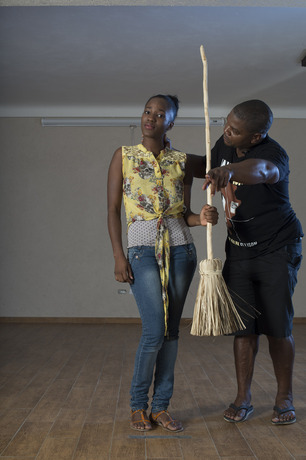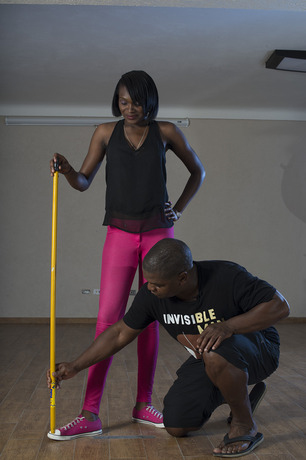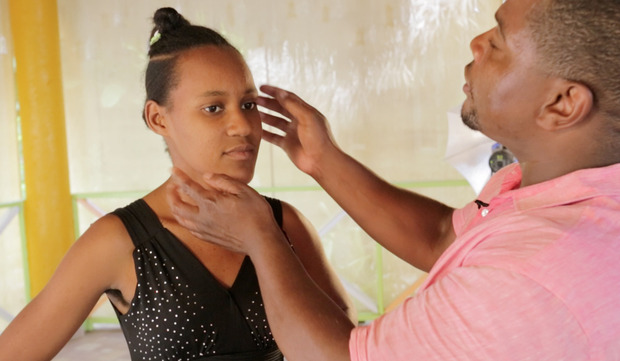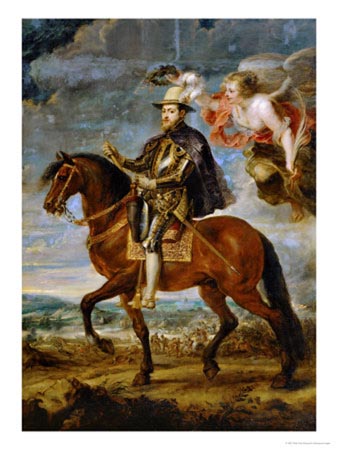Kehinde Wiley Paints “The World Stage: Haiti”
The artist hosts a pageant to find “The Face of Haiti” in his new exhibition in Los Angeles

Kehinde Wiley searches the world to find models to paint. His travels have taken him to Israel, Lagos and Dakar, China, and Jamaica. More recently, he’s traveled to six countries in Africa, where, in each destination, he stopped people on the streets, asking them to model for photographs in heroic poses based on historic paintings. Wiley then painted their image in oil on giant linen canvases creating vibrant portraits embellished with elaborate decoration.
The documentary “An Economy of Grace” shows Wiley in New York adding women to his roster of subjects—with the added element of Givenchy’s Riccardo Tisci creating couture dresses for a series of paintings. Now, Wiley (along with his Beijing studio director Ain Cocke) set up their lights and turn their camera lens to capture the beauty of the women in Haiti. This time—like previous locations where Wiley would search the streets for people to paint during their everyday activities—radio advertisements announced the model search set up as a pageant asking the nation’s women to come be “The Face of Haiti.”


Wiley met with Cool Hunting a few days before “The World Stage: Haiti” opened at LA’s Roberts & Tilton Gallery to share his thoughts on his time in Haiti, the process of making the works inspired by the trip, and his thoughts on the analog nature of painting in the 21st century.
The catastrophic earthquake in Haiti was four years ago. Is there a specific reason you chose to find people to paint there now?
My desire to work in Haiti has nothing to do with the earthquake, although you cannot ignore the lens through which many people see Haiti. So much of what I wanted to do was to try to figure out how to create work that engaged portraiture in the global south. (That includes areas like Jamaica and Brazil). Haiti had always been on the map for me. It was just a matter of timing.
Why did you decide to focus on painting women in Haiti?
So what I decided to do was sidestep the question of disaster and poverty—which are narratives we know quite well about Haiti—by going towards the fabulous. I was looking at the history of pageants and pageantry as it existed not only in the Caribbean, but also as a phenomenon globally. There was something fascinating about how that spectacle of beauty and the artifice of it could fuse with this interesting narrative of trauma and poverty and discontent.


How did you approach planning your pageant?
It was important to look at the rules of pageants. In my work there is no judge. There is the sense in which you get out there and chance becomes the arbiter of this kind of truth. That said, there was selection going on and self-selection. The women themselves are deciding, “I can be the face of Haiti.” That was the language we used in the advertisements. This was beaming out over the radio all over the island. It was really exciting to wake up those mornings and to see who would show up.
What did you find in your research of the arts, pattern and religious imagery in Haiti to include in the paintings?
What I wanted to do is look at the colonial past and to concentrate specifically on the Spanish and French influences. Haiti was ruled by the Spanish and, after that, the French. There was a concerted effort on my part to draw a line of connection between those two aesthetically, by using great paintings of the past from both Spain and France.

What we wanted to do was recreate that sense of surprise, celebration, and beauty.
How did you choose the models during the pageant audition process?
There was no winner. The women were paid for their time. We could not choose every single person who showed up each day. We had a raffle for the women that we would shoot that day. Out of that day, we had three winners of a larger cash prize just to give it that sense of chance. Ultimately there was never going to be the same rule as before, where someone is crowned the queen of the pageant. The whole thing is rather ridiculous, but in the end what we wanted to do was recreate that sense of surprise, celebration, and beauty. It was really great to start to see the women get into it and recognize how special it was on some level. They were going through my books and looking at images of paintings, getting excited about looking at historical paintings and imagining themselves in them.

So once you found your subjects in Haiti, how did you connect the subjects to the inspiration for the paintings and poses?
My studio manger Ain Cocke helps me with the lighting, photography and the technical side. He’s there with the light, making sure every moment of that comes together. I had a big binder full of images from 18th and 19th century French and Spanish paintings. It moves quickly. We match them up. How does it all start to come together as a cohesive exhibition? You start to imagine. I need a couple mega-paintings, big paintings. You start to imagine poses with multiple figures and who had the best chemistry together.
There is something that always will be true about painting and sculpture—that in order to really get it, you have to show up.
How do you feel about the fact that many people are aware of your work, but only some have seen the paintings in person?
That is the crisis of art and representation. Art in the age of the digital image is completely different from experiencing art in physical form. There is something that always will be true about painting and sculpture—that in order to really get it, you have to show up. That is something that is both sad and kind of beautiful about it. It remains analog. It remains special and irreducible. The scale. Seeing the paint and the luster. The texture.
“The World Stage: Haiti” is on view at Roberts & Tilton Gallery (5801 Washington Boulevard, Culver City, California) through 25 October 2014. The painting “The Sisters Zénaïde and Charlotte Bonaparte” will be the subject of a print published by Lapis Press to benefit Ciné Institute in Jacmel, Haiti.
Images courtesy of the artist and Roberts & Tilton, Culver City, California












